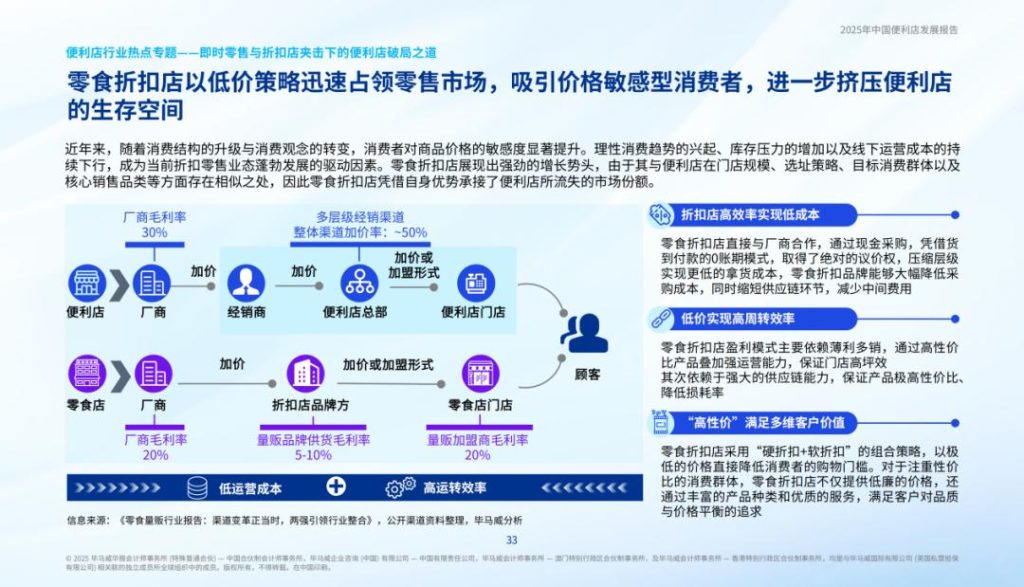
Read More《便利店的未来:用“人情味”对抗效率内卷》
Positive Reviews: Transforming Convenience Stores with “Human Touch” is the Precise Way to Break Free from the Vicious Competition
Under the long – standing “efficiency – first” logic of the retail industry, convenience stores used to be the “miniature supply stations” in urban life, with their core competitiveness lying in being “fast, nearby, and comprehensive”. However, when snack stores and discount stores siphon off customers with price advantages, and when consumers’ demand for “convenience” has evolved from “physical proximity” to “emotional connection”, the proposal in The 2025 China Convenience Store Development Report to “combat the efficiency – driven cut – throat competition with ‘human touch'” undoubtedly hits the nail on the head for the industry’s transformation – evolving from a “transaction venue” to a “life companion”.
Scenario – based Operation Reconstructs the Definition of “Convenience” and Precisely Matches Customer Needs
The traditional “product collection” model of convenience stores is essentially “finding customers through products”, relying on experience and sales data to stack up SKUs. But in today’s era of diversified consumption motives, this model can hardly meet the “task – oriented” immediate needs (such as getting a boost during commuting or having a late – night snack). The strategy of “starting from scenarios rather than product categories” proposed in the news actually redefines convenience stores as “task strongholds”. By focusing on specific scenarios (such as enhancing the display and marketing of coffee and energy drinks in the “commuting boost” scenario), products can have a “precise dialogue” with customers’ needs. This transformation can not only avoid the “price – comparison trap” with discount stores but also establish a differentiated advantage through the sense of value of “solving problems”. For example, the “ready – to – eat fresh food” strategy of 7 – Eleven in Japan has increased the proportion of fresh food to over 40% by targeting scenarios like “work lunches” and “late – night simple meals”, making it the core profit source.
Injecting Human Touch Breaks the “Cold Efficiency” and Builds Emotional Bond
The case of Fat Donglai confirms a truth that the retail industry has long ignored: consumers need not only products but also the experience of “being valued”. The “Human Touch” emphasized in the news is not just a simple service gimmick. Instead, it conveys the business philosophy of “thinking a little more for the other party” through employee care and detailed design (such as hand – written coffee cup stickers and recording regular customers’ habits). This “warmth” can significantly enhance customers’ emotional bond. When convenience store employees can call regular customers by their names, remember their preferences, and even offer an umbrella on a rainy day, customers’ motivation for repeat purchases will upgrade from “convenience” to “emotional dependence”. Data shows that for retail brands with high emotional connection, the customer lifetime value (LTV) can be increased by over 30%. For convenience stores with low customer unit price and high – frequency repeat purchases, this is a crucial growth engine.
Space Operation and Membership Upgrade: Moving from “Transaction” to “Relationship”
The “quick – buy – and – leave” model of convenience stores used to be an efficiency advantage. However, in the face of intensified competition, this model has instead restricted the customer unit price and user engagement. The strategies of “creating reasons for customers to stay” (such as setting up in – store seats and optimizing the dining experience) and “transforming the membership system from a point – based tool to a trust – based relationship” proposed in the news essentially transform convenience stores from “traffic entrances” to “life nodes”. For example, convenience stores in Taiwan attract students and office workers to stay through in – store dining areas, not only extending the consumption time (from an average of 5 minutes to 20 minutes) but also increasing the customer unit price through the “bento + soup + drink” package. The subscription – based membership (such as getting X cups of coffee for 99 yuan per month) enhances user stickiness through “habit – building” and transforms “random consumption” into “planned consumption”. This combination of “time management” and “relationship management” opens up a second growth curve for convenience stores from “product sales” to “experience – based services”.
Negative Reviews: Three Realistic Challenges to Be Alerted to in the “Human Touch” Transformation of Convenience Stores
Although the “human touch” transformation direction is of great value, convenience stores, as a retail format with high standardization and low profit margins, still face multiple realistic challenges in the implementation process. If not handled properly, they may fall into the dilemma of “great in theory but difficult in practice”.
The Contradiction between Standardization and Personalization: How to Balance Efficiency and Human Touch?
One of the core advantages of convenience stores is their highly standardized operation system (such as product display, replenishment process, and employee training), which is the basis for their rapid expansion and cost control. However, the implementation of “human touch” requires personalized services (such as recording regular customers’ habits and employees’ independent judgment), which naturally conflicts with standardized management. For example, asking employees to write hand – written coffee cup stickers may add 30 seconds per order to the operation time, potentially causing queuing congestion during peak hours. Recording regular customers’ habits requires employees to actively observe and record, which puts forward higher requirements for labor costs and training costs. If efficiency is sacrificed for excessive personalization, the operating cost of a single store may increase. Especially for small and medium – sized brands, this “warmth” may become an unbearable burden.
The Conflict between Data – driven and Experience – based Approaches: The Trial – and – Error Cost of Category Adjustment
Although tools such as the BCG Matrix and the Ansoff Matrix mentioned in the news can assist in category adjustment, the category management of convenience stores highly depends on real – time data (such as sales, time – period, and customer – group analysis from the POS system). However, the “task – oriented” demand changes may be faster than the data feedback. For example, in a certain area, the demand for “ice cream” may surge due to high summer temperatures, but the traditional sales ranking list may reflect this change with a lag. The decline in the proportion of the coffee category may be due to price cuts by competitors rather than a weakening of demand. If the coffee is directly removed from the shelves, subsequent growth opportunities may be missed. In addition, small and medium – sized convenience stores may lack big – data analysis capabilities, and adjusting categories based on experience is still the mainstream, which may lead to the contradiction between “over – reliance on experience” and “data – driven” approaches, increasing the trial – and – error cost.
The Input – Output Ratio of Space Operation: Is It Worthwhile to Encourage Customers to Stay with Low Profit Margins?
Creating “reasons for customers to stay” requires space renovation (such as adding seats and optimizing the dining environment) and service upgrades (such as providing sockets and Wi – Fi), which may be a significant expense for convenience stores. For example, adding 5 seats in a single store may occupy about 5 square meters of space (equivalent to reducing 2 – 3 sets of shelves). Can the loss of product sales be balanced by the new “stay – based consumption” (such as additional purchases of desserts and drinks)? In addition, “stay – based consumption” puts forward higher requirements for store cleaning and labor (such as clearing tables and replenishing goods). If not well – managed, it may lead to a decline in operating efficiency. For instance, a convenience store once received negative customer reviews due to the untimely cleaning of the in – store dining area, which damaged its brand image.
Suggestions for Entrepreneurs: Finding a Dynamic Balance between “Efficiency” and “Warmth”
The “human touch” transformation of convenience stores is not about overthrowing the tradition but injecting warmth on the basis of efficiency and retaining flexibility within standardization. Entrepreneurs can implement the transformation from the following three aspects:
1. Scenario – based Product Selection: Drive Decision – making with “Minute – level” Data
- Use the POS system and membership data to refine consumption scenarios into “time period + customer group + demand” (such as the “commuting boost” demand from 8 am to 9 am and the “late – night snack” demand from 10 pm to 12 am), and adjust product categories and displays accordingly.
- For small and medium – sized brands, reduce risks through “small – scale trial – and – error + rapid iteration”. For example, test the coffee + energy bar combination for the “commuting boost” scenario in 3 pilot stores, and then promote it to other stores after observing the sales data.
2. Human – touch Service: Start with “Replicable Details” and Avoid Excessive Personalization
- Design “low – cost and easy – to – standardize” warm – hearted actions. For example, print warm messages like “Cheer up today” on coffee cup stickers uniformly (instead of hand – writing) to reduce the operation time. Add basic courses on “observing customers’ habits” (such as recording regular customers’ purchase times and products) in employee training, and share the information through the system rather than relying on personal memory.
- Incorporate “warm – hearted service” into the KPI without forced quantification. For example, select the “warmest clerk” every month based on customer reviews instead of requiring employees to record a certain number of regular customers’ habits to avoid formalism.
3. Space Operation: Create High – stickiness Experience with “Low – cost Design”
- Prioritize the renovation of existing space. For example, transform the idle corner next to the cashier into a “coffee break corner” (place 2 – 3 chairs and a small table) instead of large – scale decoration. Use movable tables and chairs (such as folding stools) to flexibly adjust the space layout.
- Design packages according to “stay scenarios”. For example, launch a “bento + soup + 1 – yuan drink upgrade” package for the “lunch stay” scenario to increase the customer unit price. Provide a “simple meal + beer” package for the “night – time stay” scenario to meet the needs of late – returning customers.
4. Membership System: Upgrade from a “Tool” to a “Relationship” in Stages
- Basic stage: Collect customer behavior data (such as consumption time and product preferences) through the membership mini – program, and push “precise discounts” (such as coffee discount vouchers for customers who often buy coffee) instead of general full – amount discounts.
- Intermediate stage: Try the “subscription – based” light model, such as “20% off coffee every Wednesday” or “buy 3 breakfast vouchers for 9.9 yuan per month” to cultivate the habit of “regular visits”.
- Advanced stage: Launch a “mini – paid membership” for high – stickiness customers (such as paying 29 yuan per year to enjoy exclusive fresh food on birthdays and priority to taste new products) to strengthen trust through a sense of exclusivity.
Conclusion
The future of convenience stores lies in the coexistence of “efficiency” and “warmth”. Entrepreneurs need to clearly recognize that “human touch” is not a negation of efficiency but a supplement to it. When products, space, and services can “understand” customers, convenience stores can transform from “passing – by shops” to “indispensable companions”. This transformation may be a long – term process, but only by truly understanding “how to make progress after convenience” can convenience stores stand firm in the retail competition.





